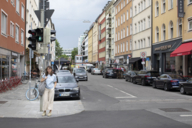
It's hard to put a label on Theresienstrasse, but between its museums, universities and betting shops, one thing quickly becomes clear: this street really has everything you could wish for in a city – packed into a mere 1.5 kilometres.
When you go to Theresienstrasse, you really are immersed in another world; whether you sit in one of the many restaurants for lunch or head to an exhibition at the Pinakothek art galleries, you will find yourself surrounded by different languages. This is partly because of the volume of visitors attracted to the Kunstareal museum area, but also because there are young people from all over the world here thanks to Ludwig-Maximilians-Universität and the TU (Technical University) – Theresienstrasse connects the two renowned universities.
When it comes to food, you really can get anything you fancy on Theresienstrasse: French pain au chocolat, Neapolitan pizza, Greek frappé or Bavarian fish caught in Schliersee lake.
This cosmopolitan flair is also reflected in the gastronomic offerings on the street, which range from Peruvian restaurant Nasca to Vietnamese-vegan eatery SOY. When it comes to food, you really can get anything you fancy on Theresienstrasse: French pain au chocolat, Neapolitan pizza, Greek frappé or Bavarian fish caught in Schliersee (lake). Rarely do you encounter such a wide variety – vegan doner kebabs, truffle doner kebabs, old school doner kebabs – where they all taste fantastic. So if you’re looking for a culinary tour of the world, Theresienstrasse in Maxvorstadt is a great place to start!
And we start that tour at Nostimo, a Greek deli that has graced the street since 2018. Store owner Nicolas wanted it to be a day bar where people could get a changing menu of fresh lunches but also good Greek olive oil and delicious wine. The shelves are packed with all the delicacies you could need for a Greek evening at home. We sit at one of the white tables in front of the light blue shop and immediately feel like we’re in the Mediterranean. We order a Greek bowl with avocado, feta and couscous, and some pasta with aubergine.
Nicolas' father is Greek and took over the gallery next door in 1980, so Nicolas himself largely grew up in the area; Theresienstrasse became something of a second home, and he has been observing the hustle and bustle here for over 40 years. “The street is definitely different from what it was back then, but it was always busy. And the gastronomy was always diverse and international, even in the past.” He still values the fact that Theresienstrasse enjoys a central location without being thronged with people.
He still values the fact that Theresienstrasse enjoys a central location without being thronged with people.
“Having so many museums and galleries around the corner means lots of passing trade, of course,” says Nicolas, “people are interested in culture and also have a certain awareness of quality.” He tells us that the street parallel to this one is generally buzzing with significantly more people and a much younger crowd. The students tend to hang out near the Pinakothek galleries, which is where we’re headed next.
One popular meeting place – not just for students – is the big green in front of the Alte Pinakothek art gallery. This is where locals, lovers, pensioners and people who work locally come together for after-work drinks, a picnic or to play some sports. Student Julia also spends a lot of time here, telling us: “The green is great for playing volleyball or just for getting some air. And there's a great view of all the beautiful buildings around here.”
One popular meeting place is the big green in front of the Alte Pinakothek art gallery. This is where people come together for after-work drinks, a picnic or to play some sports.
Julia used to live on Theresienstrasse when she came to Munich to study. She is currently in her sixth semester of an environmental engineering degree at the TU and now lives a little further away in Bogenhausen. But she spends as much time in Maxvorstadt as she used to. “I like the variety here – countless bars and restaurants, university life, loads of other students,” she says.
We walk on towards the TU until we reach Massmannpark. This is where Theresienstrasse ends, and the ambience changes again as it leads towards Schleissheimer Strasse: betting shops, nail studios, and massage parlours. Another side of the city that can also be found on this street that seems to offer everything – top-class exhibitions, but also normal city life. The apartment buildings in this area date mostly from the 1950s, as few old buildings survived the War.
This street simply cannot be pigeonholed, no matter how hard you try. Perhaps the only thing you can say about it is: if you can't find it here, it doesn't exist.
Though we do find one historic gem: at the end of the road we stumble upon one of the oldest hairdressing salons in the city. At 158 Theresienstrasse, Salon Charlotte has been here since 1904 – some of the equipment is over a hundred years old. Theresienstrasse is also home to a number of Munich chains such as The Italian Shot, Coucou Food Market and ceramics label Motel A Miio. Anyone who manages to open a branch here has got it made. And then there is the Theresienstrasse success story par excellence: the Ballabeni ice cream parlour – easily identifiable by the long queue outside.
Walking past all the universities, museums, apartments, shops, restaurants, stories and people, you quickly realise that there is really nothing lacking: Theresienstrasse is a city within the city. A self-contained system that would still function wonderfully if cut off from its surroundings – Maxvorstadt and perhaps even Munich as a whole. This street simply cannot be pigeonholed, no matter how hard you try. Perhaps the only thing you can say about it is: if you can't find it here, it doesn’t exist.